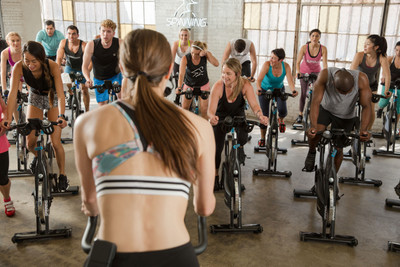
Getting F.I.T.T. in the New Year
Posted by Spinning® on Jan 4th 2019
A new year means new students! Set them off on the right track with the F.I.T.T. Principle, an effective new way to create and modify your classes to ensure your students’ success!
As we turn the page toward 2019, hundreds of new riders will be rushing to your classes eager to lose weight and get fit in the New Year. Each student will arrive with a different experience in fitness; it could be their first Spinning® class ever, or maybe their first workout in many years. Some students may be returning from injury or ready to train for their next big competition. So how do we ensure that each and every new students starts 2019 off on the right foot?
At the start of every class, begin with a proper bike setup for every new student. Give your safety speech, impart the importance of hydration, and explain the Spinning® program’s guidelines for resistance and cadence (this includes the four hand positions and nine movements). But while that information is perfect for the beginning of class, what do you do for subsequent classes to ensure they are progressing?
Proper Progression with the F.I.T.T. Principle
Progress in fitness and performance is a direct result of the proper relationship between work and rest. The best possible outcomes are achieved when training includes progression phases of stressing muscles and energy systems in addition to appropriate recovery time.
With this notion in mind, the work intensity, duration, and movement type are used to design Spinning® classes. By manipulating four key variables in your classes – frequency, intensity, time and type (F.I.T.T.) – a great instructor can create ride profiles that properly train the body’s systems to benefit every rider. You will empower students with a reason for the work ahead and inspire them to work even harder toward their goals.
Setting a Ride Plan
The F.I.T.T. Principle is discussed in detail in the Rockstar Spinning® Certification, but here is a quick look into these four key variables:
Frequency refers to the timing of your ride in terms of intervals, repeats, training variables and breaks for recovery. This variable creates a class that flows naturally from one goal to another, and it can be modified to enhance progression in classes over time in daily, weekly and monthly plans.
Intensity denotes the level of effort, or how hard or easy the work is during a ride. As one of the most important training components, intensity is used to increase progression and fitness adaptations. As Spinning® instructors, we have multiple ways to measure intensity, including heart rate, power (measured in watts) and a rider’s rating of perceived exertion. Before creating your ride profile, ask yourself: “What intensity should be performed, to achieve the training goal?”
Time is a critical part of building endurance. It not only encapsulates the total duration of the ride, but also the intensity or techniques involved in each session. It is essential to provide an appropriate time to overload the systems at various intensities and to incorporate recovery time to allow physical adaptations to occur.
Last but not least, type refers to the techniques used to achieve a certain intensity or goal. In the Spinning® program, this means the movements and terrains that we incorporate in our classes. Achieving a certain goal involves multiple movements or techniques, so it is common that you will incorporate a variety of movements and intensities to maximize positive physiological and mental responses to training.
The F.I.T.T. Principle in Action
So how do we manipulate these principles to achieve a certain goal? Let’s look at an example.
“During this ten-minute effort, ride in a Seated Climb for two minutes at an RPE of 5, then in a Standing Climb for 30 seconds at an RPE of 8. Repeat these movements four times.”
Now what if we want to make this effort less intense for some students who are new to exercise? We can adjust the frequency by completing only three intervals instead of four. For intensity, we can dial the RPE back from 5 to 3 and from 8 to 6. For time, reduce the total time to eight minutes. And the type, or movements, can be adjusted for our new students by turning a hill into a flat road. Let’s look at same example, now modified for new students:
“During this eight-minute effort, ride in a Seated Flat for two minutes at an RPE of 3, then in a Standing Flat for 30 seconds at an RPE of 6. Repeat these movements three times.”
But what if we want to adjust this effort for more experienced riders, maybe students that are training for an outdoor competition. Let’s turn it up! We can increase the frequency to six intervals, the intensity up to RPEs of 6 and 9, the time to twelve minutes, and the type back to a hill. Now let’s look at the example above designed for performance cyclists looking for a challenge:
“During a twelve-minute effort, ride in a Seated Climb for two minutes at an RPE of 6, then in a Standing Climb for 30 seconds at an RPE of 9. Repeat these movements six times.”
Just by manipulating these F.I.T.T. principles, you can devise any plan you like for any population or purpose of your class. This principle will ensure that every new student in your Spinning® classes begins 2019 off on the right track!
This article was contributed by Greg Mantell – Director of Content Management, Mad Dogg Athletics, Inc.
